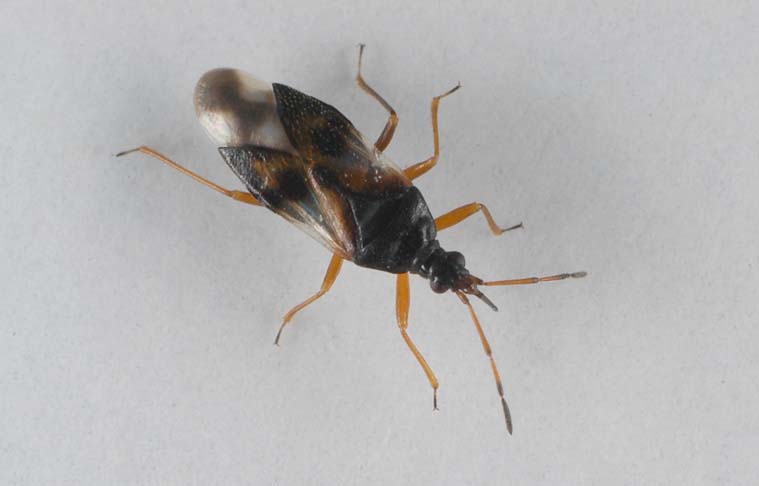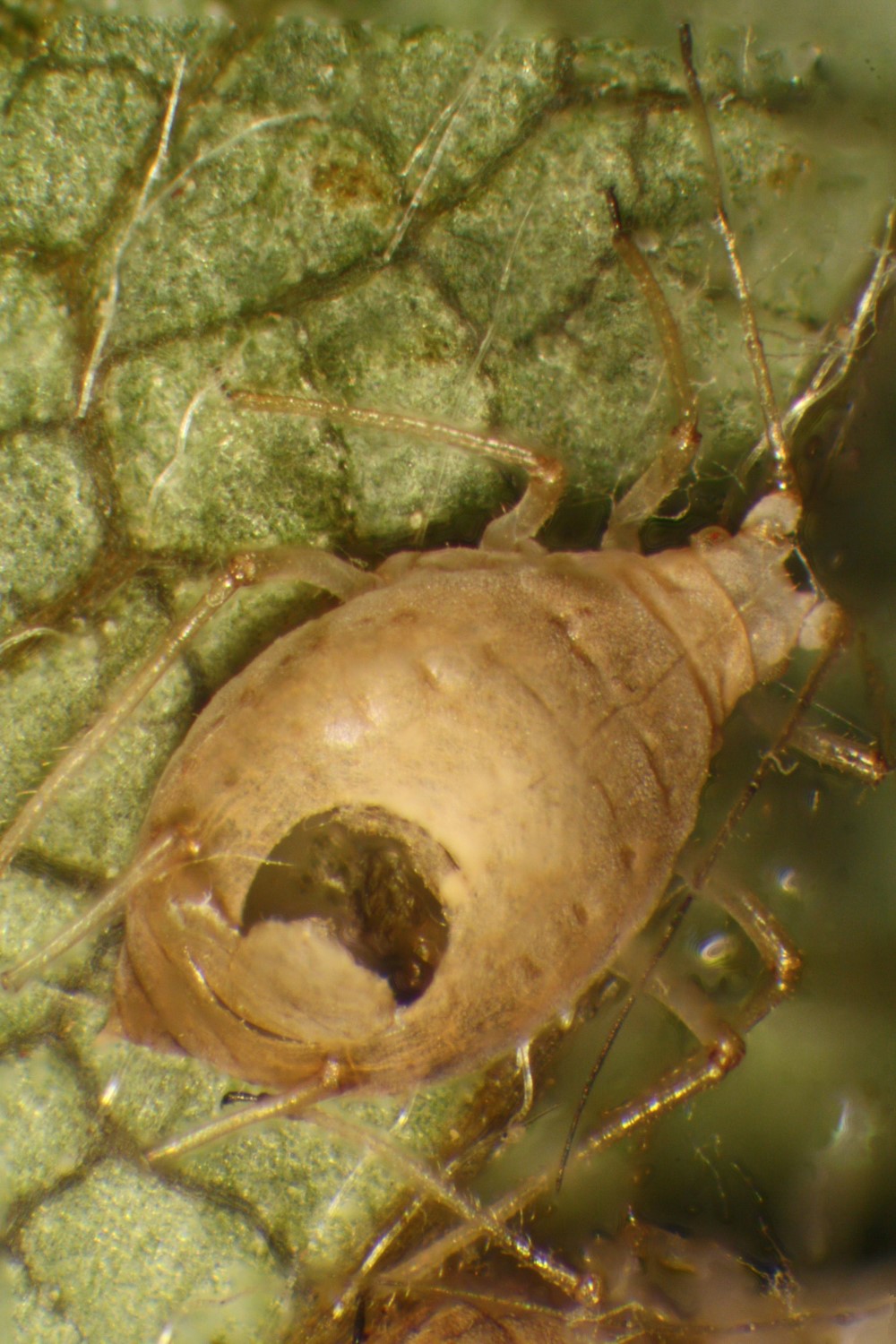Please click here to access the main AHDB website and other sectors.
- Home
- Knowledge library
- Aphids on strawberry: cultural and natural control
Aphids on strawberry: cultural and natural control
Before implementing biological or spray control measures, growers can manage strawberry crops in ways to deter aphid population increase, while relying on naturally occurring beneficial insects to suppress aphids. Read more about the options available.
Back to: Control methods for aphids on strawberry
Cultural control
Growers should avoid using excess nitrogen fertiliser, as aphid numbers tend to be especially high on plants that receive too much nitrogen. Some of the aphid pests of strawberry (e.g. potato aphids, and melon and cotton aphids) are generalist feeders and can move from feeding on weed species to colonise strawberry plants.
Good management of weeds in and around tunnels can therefore help to reduce risk of aphid attacks.
Other plants have repellent properties for aphids and some growers have found that interplanting of garlic with strawberry plants helps to suppress aphids.
Garlic planting
In experiments carried out as part of Project SF 156, strawberry plants in tunnels were intercropped with garlic (by planting garlic cloves directly in grow bags). Garlic leaves were broken fortnightly and laid onto the crop. Alongside these were other groups of strawberry plants without garlic. The garlic treatment significantly reduced strawberry aphid numbers compared with untreated plants.
Breaking garlic leaves possibly releases volatiles which repel aphids and is sustained by the continuous presence of garlic plants in the crop. However, this experiment was only conducted for one year and it is currently unclear whether this reduction is sufficient to reduce C. fragaefolii damage to the crop.
Natural control
Controls introduced by growers should be sensitive to the natural enemies likely to enter the crop later in the season.
It is worthwhile learning to recognise the main groups of aphid enemies and looking out for signs of these in and around the crop. These beneficials need alternative food sources in the local environment of the crop, so they can be encouraged by planting biodiverse seed mixes around field margins and tunnel edges. However, before June/July, there tend to be few natural enemies of aphids in and around strawberry crops and therefore other control measures should be employed to suppress aphid populations until natural numbers build.
Predators
Aphids are preyed on by a wide range of generalist predatory arthropods, including ladybirds, spiders, rove beetles, lacewing and hoverfly (syrphid) larvae, predatory flower bugs (Anthocoris and Orius sp.) and other predatory bugs and mites.
Several studies have shown that spiders are often the most abundant group of predators. Over 20 species may be present. The predatory flower bug Anthocoris nemorum (see below) is one of the commonest predatory bugs that feed on aphids on strawberry, but the smaller species Orius niger, Orius majusculus and Orius laevigatus also occur naturally in summer, as well as nabid bugs and predatory mirids.
Anthocoris nemorum adult

Image copyright NIAB EMR.
Ladybird and lacewing larvae may also occur in small to moderate numbers.
Other common predators include:
- The rove beetles Tachyporus hypnorum and Tachyporus obtusus
- The predatory mite Anystis agilis
Many species of ground beetle (carabids) that occur in strawberry fields (some feed on strawberry fruits) are known to be predators of aphids in cereal fields and they may contribute to aphid control in field-grown organic strawberry crops. Their role as predators of aphids in strawberry crops is largely unknown. One of the factors likely to influence their importance is the extent to which they will climb onto plants to seek prey. Experiments at NIAB EMR showed that some species can climb onto strawberry leaves in the field, but they are unlikely to be a benefit in tabletop production.
The relatively short life of modern strawberry plantings counts against the establishment of large natural-enemy populations. In addition, the use of some spray products (particularly broad-spectrum products such as pyrethroids) are harmful to natural enemies. Growers may decide to use such products (e.g. Hallmark) as a ‘clean-up’ measure in early spring to control overwintered aphids present in the crop, but care should be taken with this approach, as the later in the season such sprays are applied, the greater their impact on aphid natural enemies is likely to be.
Because strawberry crops are ‘forced’ in early spring, the typical build-up of natural enemies migrating into the crop from surrounding habitats often lags behind the rapid development of aphid populations.
Natural enemies become a significant aphid-controlling factor when weather and plant growth conditions are favourable in spring and summer. However, aphid numbers can sometimes reach damaging levels despite the presence of large numbers of predators. Because aphids, in particular strawberry aphid, are virus vectors, the numbers of aphids that can be tolerated are rather low. The natural-enemy complex cannot regulate them consistently to such low levels. Supplementary introductions of predatory insects, such as predatory midges (e.g. Aphidoletes aphidimyza), lacewing larvae or, more recently, hoverflies, can be made for biocontrol of aphids in protected strawberry crops (link to biocontrol subpage).
Parasitic wasps
Mummies of aphids parasitised by parasitic wasps (parasitoids) such as Aphelinus and Aphidius sp. are often numerous in strawberry crops with large aphid populations, particularly in summer. Hyperparasites, which parasitise the parasitoids, may reduce their effectiveness.
Though natural parasitoid populations and parasitism rates may be high, aphid numbers may still reach damaging levels. Supplementary introductions of parasitic wasps can be made for biocontrol of aphids in protected strawberry crops. This is best done in early spring and parasitoids need to be released well before aphids become a problem and even before they are detected. This is because of the lag with natural control – explained above.
A mummy formed by an Aphidius species and the exit hole where the adult parasitoid has emerged

Photo by Dr Tom Pope, image copyright RSK ADAS, used with permission.
Fungi and microbial agents
Outbreaks of the fungal insect pathogen Entomophthora planchoniana occur naturally in strawberry aphid populations, usually in prolonged periods of moderately warm, very humid conditions. Outbreaks are irregular in time and intensity and only occasionally play a significant part in regulating aphid populations. This natural pathogen cannot be easily cultured in artificial media and therefore cannot currently be used as a biocontrol agent, though other pathogenic species may offer opportunity.
Enhancing natural enemies
Persistent, broad-spectrum spray products, particularly synthetic pyrethroids, are harmful to a wide range of natural enemies and their use should be avoided, especially later in the season when natural enemies are building up in the crop. The best way of increasing natural enemies is to avoid the use of such products, using only selective aphicides or cultural, biological and biotechnological control approaches. However, an alternative approach may be to apply a single application in very early spring when numbers of aphids are detected and building but natural enemies are absent from the crop. This will keep the aphid numbers in check until natural enemies build in the crop.
- Work carried out as part of Project SF 156 demonstrated that, from June onwards, a mixed community of aphid natural enemies becomes well established in field-grown strawberry crops and helps to control aphid pests. The aphid enemies recorded included green lacewings, ladybirds, hoverflies and parasitoids, but there was a greater diversity of these beneficial insects in ever-bearers than in June-bearer crops
- Populations of natural enemies can be increased by providing stable habitats with a diverse range of plants around the plantation. There is little practical opportunity of increasing plant diversity in plantations themselves. However, consider limiting the size of plantations and providing wildlife areas. It should be noted that some pests (e.g. strawberry blossom weevil) use such areas as overwintering sites
- Successive sowing of flowering herbs in and around the plantation will provide an alternative food source for some natural enemies, notably hoverfly adults, the larvae of which are predators of aphids. But consider sowing a perennial wildflower mix, which, with careful management, can last ten years or more. Care in choice of species is important as many flowering plants are hosts to the European tarnished plant bug or common green capsid, damaging pests of strawberries at low population densities (see AHDB factsheet 19/04). More research is needed to determine which plant species should be included in the floral mixes adjacent to strawberry crops to maximise natural enemies but minimise pests

